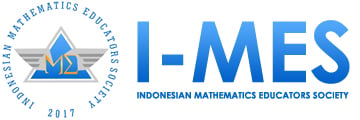ANALISIS BIBLIOMETRIK TERHADAP KONSEP MATEMATIKA BERDASARKAN CONSEPTUAL UNDERSTANDING BERBASIS VOSVIEWER
DOI:
https://doi.org/10.33752/cartesian.v2i2.3360Keywords:
Kata Kunci : Bibliometrik, Konsep Matematika, Pemahaman KonseptualAbstract
Dalam mempelajari ilmu matematika, banyak terjadi miskonsepsi dan tidak paham konsep ketika peserta didik mempelajarinya. Kurangnya pemahaman konsep ketika mempelajari matematika akan menyulitkan peserta didik dalam memecahkan masalah matematika. Tujuan dari penelitian ini yaitu untuk mengetahui tren penelitian konsep matematika, untuk mengetahui bagaimana klasfikasi artikel penelitian konsep matematika dan mengetahui tema penelitian konsep matematika yang memiliki peluang untuk dijadikan penelitian di masa mendatang. Metode dalam penelitian ini yaitu menggunakan analisis bibliometrik. Data penelitian diperoleh melalui perangkat lunak Harzing’s Publish or Perish dengan database Google scholar, kata kunci Mathematics Concept dan hasil nomor maksimal “1000â€, artikel yang didapat sebanyak 980 artikel dengan jangka waktu tahun 1936 – tahun 2022. Hasil penelitian menunjukkan bahwa tema penelitian Mathematics Concept yang memiliki peluang untuk dijadikan penelitian dimasa mendatang terdapat empat kata kunci yaitu Etnomathematics, Mathematics Problem, Meta Analysis, dan Academic Self Concept.
Downloads
References
Bong, M., & Skaalvik, E. M. (2003). Academic Self-Concept and Self-Efficacy: How Different Are They Really? 15(1), 1–40.
Donthu, N., Kumar, S., Mukherjee, D., Pandey, N., & Lim, W. M. (2021). How to conduct a bibliometric analysis: An overview and guidelines. Journal of Business Research, 133(May), 285–296. https://doi.org/10.1016/j.jbusres.2021.04.070
Egger, M., Smith, G. D., & Phillips, A. N. (1997). Meta-analysis: Principles and procedures. British Medical Journal, 315(7121), 1533–1537. https://doi.org/10.1136/bmj.315.7121.1533
Glanzel, W. (2003). BIBLIOMETRICS AS A RESEARCH FIELD : A course on theory and application of bibliometric indicators. cin.ufpe.br/~ajhol/futuro/references/01%23_Bibliometrics_Module_KUL_BIBLIOMETRICS AS A RESEARCH FIELD.pdf
Hardiarti, S. (2017). Etnomatematika : Aplikasi Bangun Datar. Aksioma, 8(2), 99–110.
Hoosain, E. (2004). What Are Mathematical Problems? Humanistic Mathematics Network Journal, 1(27), 1–8. https://doi.org/10.5642/hmnj.200401.27.12
Istiyani, R., Muchyidin, A., & Rahardjo, H. (2018). Analysis of student misconception on geometry concepts using three-tier diagnostic test. Cakrawala Pendidikan, 37(2), 223–236.
Jacsó, P. (2009). Calculating the h-index and other bibliometric and scientometric indicators from Google Scholar with the Publish or Perish software. Online Information Review, 33(6), 1189–1200. https://doi.org/10.1108/14684520911011070
Kilpatrick, J., Swafford, J., & Findell, B. (2005). Adding It Up : Helping Children Learn Mathematics. In National Academy Press.
Mallig, N. (2010). A relational database for bibliometric analysis. Journal of Informetrics, 4(4), 564–580. https://doi.org/10.1016/j.joi.2010.06.007
Marina, M., & Izzati, N. (2019). Eksplorasi Etnomatematika pada Corak Alat Musik Kesenian Marawis sebagai Sumber Belajar Matematika. Jurnal Gantang. https://doi.org/10.31629/jg.v4i1.1027
Mulyatna, F., Karim, A., & Wiratomo, Y. (2022). Eksplorasi Kembali Etnomatematika Pada Jajanan Pasar Di Daerah Cileungsi. Jurnal Cartesian (Jurnal Pendidikan Matematika), 1(2), 76–84. https://doi.org/10.33752/cartesian.v1i2.2477
Pendlebury, D. A. (2010). WHITE PAPER Using Bibliometrics in Evaluating Introduction : the main tool of science. Thomson Reuters.
Restuningsih, & Khabibah, S. (2021). Analisis Kesalahan Siswa Dalam Pemecahan Soal Cerita Materi Persamaan Dan Pertidaksamaan Linier Satu Variabel. Jurnal Cartesian (Jurnal Pendidikan Matematika), 1(1), 32–41. https://doi.org/10.33752/cartesian.v1i1.2078
Suwito, A. (2015). Miskonsepsi dan Kesalahan Konsep Gemetri Pada Siswa SMA (pp. 1–9).
Tall, D., & Vinner, S. (1981). Concept image and concept definition in mathematics with particular reference to limits and continuity. Educational Studies in Mathematics, 12(2), 151–169. https://doi.org/10.1007/BF00305619
Trenggonowati, D. L., Herlina, L., Febianti, E., Ilhami, M. A., Muharni, Y., Kurniawan, B., Kulsum, & Irman, A. (2022). Bibliometric Analysis of University Timetabling Using Publish and Perish. Proceedings of the Conference on Broad Exposure to Science and Technology 2021 (BEST 2021), 210(Best 2021), 307–311. https://doi.org/10.2991/aer.k.220131.047
van Eck, N. J., & Waltman, L. (2010). Software survey: VOSviewer, a computer program for bibliometric mapping. Scientometrics, 84(2), 523–538. https://doi.org/10.1007/s11192-009-0146-3
Wigner, E. P. (1990). The Unreasonable Effectiveness of Mathematics in the Natural Sciences. https://doi.org/10.1007/978-3-319-28163-6_2
Yulian, V. N., & Wahyudin. (2018). Analysing categories of mathematical proficiency based on Kilpatrick opinion in junior high school. Journal of Physics: Conference Series, 1132(1). https://doi.org/10.1088/1742-6596/1132/1/012052
Yuningsih, N., Nursuprianah, I., & Manfaat, B. (2021). Eksplorasi Etnomatematika pada Rancang Bangun Rumah Adat Lengkong. Jurnal Riset Pendidikan Matematika Jakarta, 3(1), 1–13. https://doi.org/10.21009/jrpmj.v3i1.19517
Downloads
Published
How to Cite
Issue
Section
License
Copyright (c) 2023 Cartesian: Jurnal Pendidikan Matematika

This work is licensed under a Creative Commons Attribution-ShareAlike 4.0 International License.
The Authors submitting a manuscript do so on the understanding that if accepted Cartesian: Jurnal Pendidikan Matematika (e-ISSN: 2809-0918) for publication, copyright publishing of the article shall be assigned/transferred to Mathematics Education Department, Universitas Hasyim Asyari Jombang, Indonesia as publisher of the journal.
The contents of the articles and advertisements published in the Cartesian: Jurnal Pendidikan Matematika are the sole and exclusive responsibility of their respective authors and advertisers.












